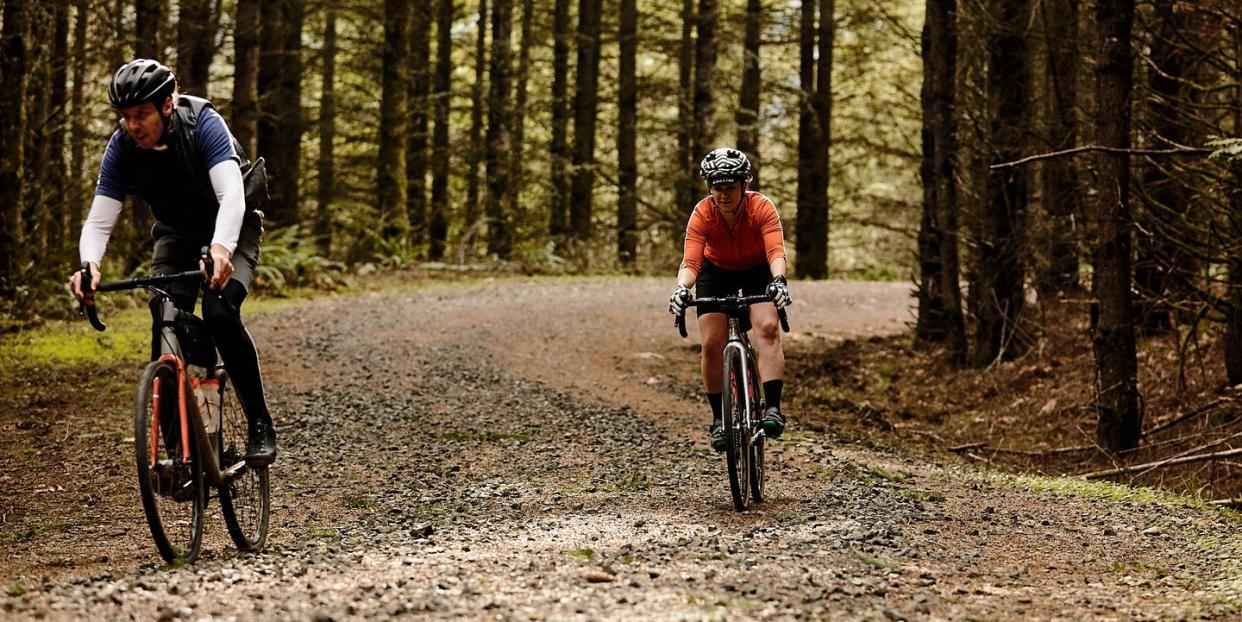It Makes Sense Why You Feel So Tired and Hungry After a Long Gravel Ride

The vibration from riding road-style bikes on rough surfaces makes supporting muscles in the calves, forearms, and triceps work harder than they do on pavement, according to a new study published in Medicine & Science in Sports & Exercise.
Riding on rough roads like cobbles and gravel also uses more energy, because it is more of a full-body activity. The study showed that riders’ heart rates were 7 percent higher and they used 2.7 percent more oxygen when riding with road vibration than riding without road vibration.
Using vibration-dampening gear like wider tires and front suspension may help save energy and spare muscle fatigue.
It’s a phenomenon that often takes new (and sometimes not-so-new) gravel riders by surprise, especially if you’re coming from the pavement: You sign up for a 100-mile gravel ride, confident from having a bunch of road centuries under your belt, and about 50 miles—and many hours—in, you’re out of food, you’re shaking the last drops of liquid from your bottles, and your triceps feel like they are going to give up the ghost if you go another mile.
What gives? The gravel gives, that’s what. Chunky, bumpy, stuttery roads give off loads of vibration that oscillates through your arms, legs, back, and other stabilizing muscles. It wears them down, raises your heart rate, and forces you to use more oxygen at any given power output.
Want to start riding gravel? Get Bicycling All Access for the latest tips and advice
Those are the findings of a new study published in Medicine & Science in Sports and Exercise that monitored 30 trained cyclists as they performed a laboratory test designed to simulate the metabolic and muscular demands of pedaling at different intensities over rough roads and cobblestones.
The cyclists pedaled at various intensities meant to simulate a race situation on a bike attached to two plates that sent vibrations into the front and rear dropouts to replicate what they would experience riding over uneven road surfaces while researchers measured their heart rate, oxygen use, and muscle activation in their arms, legs, and torso.
The researchers found that all the supporting muscles that basically come along for the ride on pavement are called into action when the road gets rough. Activity in the calves, triceps, and forearms especially increased while pedaling on a vibrating bike.
Pedaling through vibration also took more energy. The riders’ heart rates were 7 percent higher and they used 2.7 percent more oxygen during the vibrating simulation than when they rode without the vibration. And that’s just during a half hour test. Little wonder people are so beat down when faced with 100, or even 200 miles, of those conditions.
“I’ve always felt that there is a cost to rough roads that isn’t necessarily easy to quantify,” said Hunter Allen, founder of Peaks Coaching Group, who runs gravel-specific camps to help riders prepare for those demands.
“So many times we have to ‘tense’ our body above our bikes in order to stabilize our bikes and that isometric contraction uses energy,” Allen said. “Riding on a smooth road on the road bike, you can just ‘relax’ into the bike position and focus on pedaling harder, instead of dealing with stabilization of the bicycle. There is an additional energy cost just in handling the vibration on rough roads.”
What does that mean for the gravel curious? “Train to the demands of the event,” Allen said. “If you are a road rider and expect to hop on a gravel bike and jump in the weekend’s gravel fondo without any additional energy cost, think again. So, train on those gravel roads before any event!”
Also, pack more snacks. You’ll be out there longer, because gravel is slower going. Plus, you’re using more energy.
“Be sure that you have extra food in those pockets,” Allen said. “And be sure they are easy to eat while bouncing down an old country gravel road.”
Finally, consider taking some of the sting out of the rough surfaces with wider, tubeless tires, suspension stems, and other vibration dampening technology.
You Might Also Like

